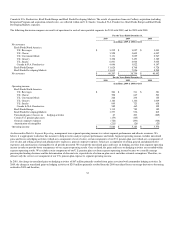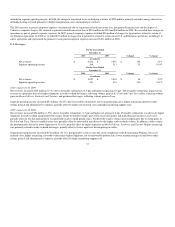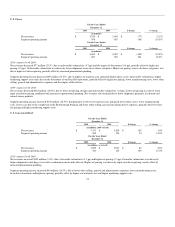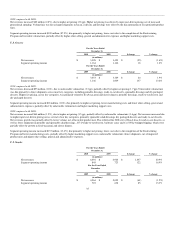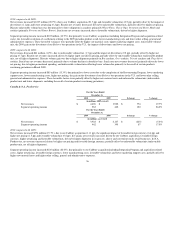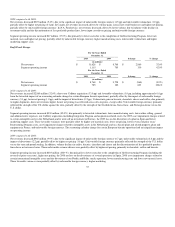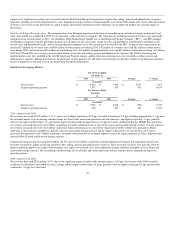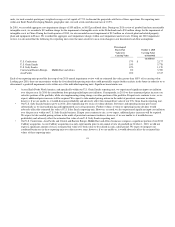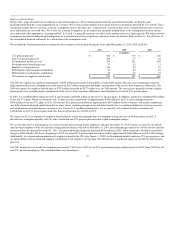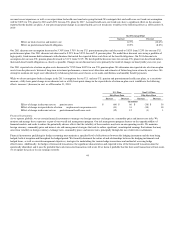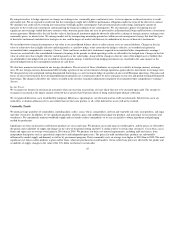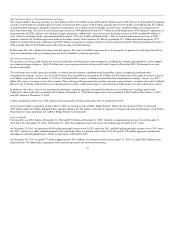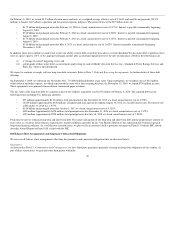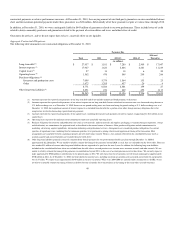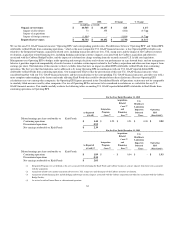Kraft 2010 Annual Report Download - page 45
Download and view the complete annual report
Please find page 45 of the 2010 Kraft annual report below. You can navigate through the pages in the report by either clicking on the pages listed below, or by using the keyword search tool below to find specific information within the annual report.
As part of the 2009 annual review of goodwill and non-amortizable intangible assets, we recorded a $12 million charge for the impairment of intangible assets
in the Netherlands. In addition, during 2009 we recorded a $9 million asset impairment charge to write off an investment in Norway. We recorded the
aggregate charges within asset impairment and exit costs.
During the fourth quarter of 2008, we completed the annual review of goodwill and non-amortizable intangible assets and recorded a $44 million charge for
the impairment of intangible assets in the Netherlands, France and Puerto Rico. In addition, in December 2008, we reached a preliminary agreement to divest
a juice operation in Brazil and reached an agreement to sell a cheese plant in Australia. In anticipation of divesting the juice operation in Brazil, we recorded
an asset impairment charge of $13 million in the fourth quarter of 2008. The charge primarily included the write-off of associated intangible assets of $8
million and property, plant and equipment of $4 million. In anticipation of selling the cheese plant in Australia, we recorded an asset impairment charge of
$28 million to property, plant and equipment in the fourth quarter of 2008. Additionally, in 2008, we divested a Nordic and Baltic snacks operation and
incurred an asset impairment charge of $55 million in connection with the divestiture. This charge primarily included the write-off of associated goodwill of
$34 million and property, plant and equipment of $16 million. We recorded the aggregate charges within asset impairment and exit costs.
Insurance and Self-Insurance:
We use a combination of insurance and self-insurance for a number of risks, including workers' compensation, general liability, automobile liability, product
liability and our obligation for employee health care benefits. Liabilities associated with the risks are estimated by considering historical claims experience
and other actuarial assumptions.
Revenue Recognition:
We recognize revenues when title and risk of loss pass to customers, which generally occurs upon shipment or delivery of goods. Revenues are recorded net
of consumer incentives and trade promotions and include all shipping and handling charges billed to customers. Kraft Foods' shipping and handling costs are
classified as part of cost of sales. A provision for product returns and allowances for bad debts are also recorded as reductions to revenues within the same
period that the revenue is recognized.
Selling, general and administrative expenses:
Marketing Costs - We promote our products with advertising, consumer incentives and trade promotions. These programs include, but are not limited to,
discounts, coupons, rebates, in-store display incentives and volume-based incentives. We expense advertising costs either in the period the advertising first
takes place or as incurred. Consumer incentive and trade promotion activities are recorded as a reduction to revenues based on amounts estimated as being due
to customers and consumers at the end of a period. We base these estimates principally on historical utilization and redemption rates. For interim reporting
purposes, advertising and consumer incentive expenses are charged to operations as a percentage of volume, based on estimated volume and related expense
for the full year. We do not defer costs on our year-end consolidated balance sheet and all marketing costs are recorded as an expense in the year incurred.
Environmental Costs:
We are subject to laws and regulations relating to the protection of the environment. We accrue for environmental remediation obligations on an undiscounted
basis when amounts are probable and can be reasonably estimated. The accruals are adjusted as new information develops or circumstances change.
Recoveries of environmental remediation costs from third parties are recorded as assets when recovery of those costs is deemed probable. At December 31,
2010, our subsidiaries were involved in 74 active actions in the U.S. under Superfund legislation (and other similar actions and legislation) related to current
operations and certain former or divested operations for which we retain liability.
Outside the U.S., we are subject to applicable multi-national, national and local environmental laws and regulations in the countries in which we do business.
Outside the U.S., we have specific programs across our business units designed to meet applicable environmental compliance requirements.
As of December 31, 2010, we had accrued an insignificant amount for environmental remediation. Based on information currently available, we believe that
the ultimate resolution of existing environmental remediation actions and our compliance in general with environmental laws and regulations will not have a
material effect on our financial results. However, we cannot quantify with certainty the potential impact of future compliance efforts and environmental
remediation actions.
42


